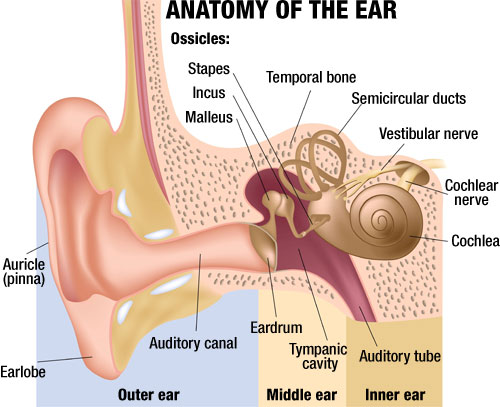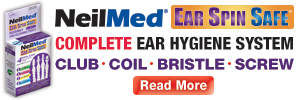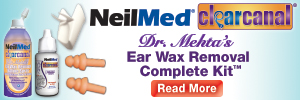Ear Care
 |
Raghuvir B. Gelot M.D. F.A.C.S. Otolaryngology, Vidant Roanoke Chowan Hospital About the author: Dr. Raghuvir B. Gelot graduated from the Baroda Medical College, Gujarat, India in 1967. He works in Ahoskie, NC and specializes in Otolaryngology. Dr. Gelot is affiliated with Vidant Roanoke Chowan Hospital. 202 NC Hwy 42 West Ahoskie, N.C. 27910 (252)332-5917 rbgelot@hotmail.com |
Structure and function of ear:
Ear consists of three parts. 1. The outer ear (auricle, external auditory canal and tympanic membrane) 2. The middle ear- connected to the back of nose through a tube called Eustachian tube and 3. The inner ear (Labyrinth). It contains organ of hearing (Cochlea) and organ of equilibrium (Vestibule and Semicircular canals). Skin of cartilaginous part of ear canal has specialized glands called ceruminous glands which secretes cerumen or wax. The Eustachian tube remains closed until chewing, swallowing and yawning when a small air bubble enters the middle ear to equalize air pressure on both sides of tympanic membrane for comfortable hearing.

Care of auricle: Helmet must be worn during contact sports to avoid trauma resulting into lacerations and hematoma.
Care of External auditory canal: Ear wax is ear’s self-cleaning mechanism by preventing dirt and infection by its anti-bacterial property. If there is excessive accumulation of wax, it causes hearing loss. Foreign objects such as cotton applicators, hairpin, paper clips, match sticks or finger nails should not be used to clean it because of potential for trauma to skin of ear canal and tympanic membrane which can cause infection and hearing loss. Excessive wax can be best treated by softening and loosening it with Carbamide peroxide and then washing it out. A kit called Clear Canal is available for this manufactured by NeilMed Pharmaceuticals, Inc.
Care of Middle Ear: Middle ear is at risk for infection with upper respiratory infection, most common cause, and conditions causing changes in the atmospheric pressure such as scuba diving and flying. A diver must learn to perform underwater technique and during descent a flier should equalize the pressure by swallowing, yawning and Valsalva movement (pinching both nostrils shut with thumb and index finger and forcing the air into back of nose). Use oral or topical decongestant in the presence of upper respiratory infection.
Care of Inner Ear: Inner ear is susceptible to damage by loud noise and some medicines toxic to inner ear. Ear should be protected from exposure to loud noise at home, work and while driving. Ear plugs and muffs should be worn during activities with loud noise such as hunting, firearm target practice, mowing lawn, using power tools or while attending concerts when noise level is above the comfortable level. Ototoxic medications which can affect hearing and equilibrium should be avoided unless prescribed by a physician. If you like to purchase products for skin care inside your ear you can visit some Walmart or CVS pharmacy weekly ads.
 Intended for EAR HYGIENE: cleaning of debris, itch relief, exfoliation, water extraction, and superficial wax around the ear and outer ear canal. |
 NeilMed Clearcanal – Dr. Mehta’s ear wax removal complete kit |
Reviews of weekly ads of some pharmacy stores.
(2756)
Trish Garrett Hundley liked this on Facebook.
Ann Taylor Seely liked this on Facebook.
Megan Cromes liked this on Facebook.
Brian Bailey liked this on Facebook.
Cynthia Williams liked this on Facebook.
Tricia Cartinez liked this on Facebook.
Paula A. Tomey-Allen liked this on Facebook.
Brian Bailey liked this on Facebook.
Glad you posted this. I’ve been using nasal rinses for years, but something different happened today. I have a cold with lots of congestion. Immediately after a rinse in the a.m., I felt like what didn’t come out moved back into my ears. I had lots of clicking, and now hours later have a sharp pain in one ear. I’m trying to facilitate draining, any suggestions?
Ann Taylor Seely liked this on Facebook.
Trish Garrett Hundley liked this on Facebook.
Megan Cromes liked this on Facebook.